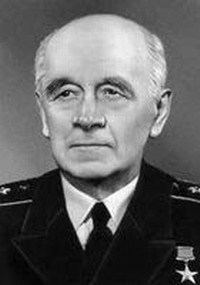Years of service 1914-1953 Name Aksel Berg | Rank Admiral | |
 | ||
Born November 10, 1893Orenburg, Russia ( 1893-11-10 ) Commands held head of the Soviet Naval Research Institute Battles/wars World War IRussian Civil WarWorld War II Awards Hero of Socialist LabourOrder of Lenin (three times)Order of the Red Banner (twice)Order of the October RevolutionOrder of the Red StarOrder of the Patriotic War Service/branch | ||
Aksel Ivanovich Berg (Orenburg 1893 – Moscow 1979) was a Soviet scientist and Navy Admiral (in Engineering). He was a key figure in the introduction of cybernetics to the Soviet Union.
Contents
- Early life
- Imprisoned and rehabilitated
- After World War II
- Selected publications
- Honours and awards
- References

Early life
Berg's father was General Johan (Ivan) Berg, of Finland-Swedish origin, and his mother was Italian. Aksel was 11 when his father died, and Aksel was matriculated to Saint Petersburg navy school. Berg joined the Imperial Russian Navy in 1914 and served as junior navigating officer on the Russian battleship Tsesarevich and as liaison officer on the British submarine HMS E8, which was operating in the Baltic in alliance with Russia. After the revolution Berg served in the Red Navy 1918–22. In 1918 he participated in the Ice Cruise of the Baltic Fleet. In 1919 he was navigating officer on the submarine Pantera when it sank the British destroyer HMS Vittoria. He subsequently commanded the submarines Rys, Volk and Zmeya. From 1925 Berg was based onshore and completed his education at the Saint Petersburg Polytechnical University. From 1927 he was assigned to the navy radio electronics department and from 1932 to 1937 he headed the Navy Communications Research Institute.
Imprisoned and rehabilitated
During Stalin's purges, Berg was imprisoned for three years, but was freed and rehabilitated in 1940, when Stalin became interested in developing radar. Berg was immediately appointed as minister of electronic technology of the USSR. He developed the Redut-K air-warning radar which was placed aboard the light cruiser Molotov in April 1941. Molotov´s device enabled her to play a key role in the air defense of Sevastopol in the first stages of Operation Barbarossa.
After World War II
After the war Berg directed the Radioelectronics Institute 1947–57 and was a Deputy Minister of Defence 1953–57. Then in 1958 he founded the Scientific Council of Complex Problem Cybernetics of which he became head. His main interests were radio communications, microelectronics and cybernetics (i.e. computer science and engineering).
Berg died in Moscow in 1979 and is buried in Novodevichy Cemetery.
Selected publications
Berg A., (1964), 'Cybernetics and Education' in The Anglo-Soviet Journal, March 1964, pp. 13–20 (English language)
